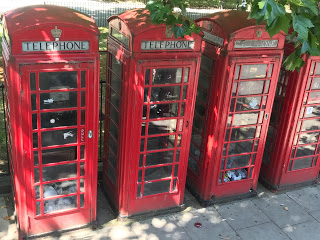 Or: Why Are London’s Telephone Boxes Red?
Or: Why Are London’s Telephone Boxes Red?
Good question. I’d been wondering the same thing so I’ve been researching…
Firstly, they’re not all red, there are a few here and there that are black. This is how you can tell the ones that aren’t owned by British Telecom as they currently own the copyright for the design of the red ones. They didn’t design it though.
The landscape today could have been dotted with 77,000 yellow telephone boxes (there are currently 8,000 red boxes plus others of various designs and colours). as when British Telecom took over from the General Post Office (GPO) in the early 1980s, that was their corporate colour. They announced the change, the people spoke and the people won. It was even discussed in Parliament.
It’s not too surprising there was a massive outcry. The British public have since voted the red boxes as one of their Top Ten Designs from the 1900s in a competition organised by the Design Museum and BBC.

It’s not too surprising this was overturned since the British public voted the red boxes as being in the Top 10 Design Icon since the 1900s
The famous red ones, were designed by architect Sir Giles Gilbert Scott as part of a competition back in 1923/4 because no-one really thought much of the design that was previously in use.
The Royal Fine Art Commission was formed to oversee a competition as there were a few other organisations (including the GPO) who were independently looking into alternate designs at the time.
Interestingly, Sir Scott wanted the box to be painted in silver but the Post Office decided on red. Perhaps it was to match the postboxes.
It also decided to make it in iron rather than Sir Scott’s suggestion of steel. Likely to be a cost-related decision.
It was known as K2 (Kiosk 2) since it was replacing the K1 model. Distinct lack of imagination with names.
 Now it’s the K6 which is most popular. This is the one designed for King George V Silver Jubilee in 1935. There’s some aesthetic changes as well as construction materials.
Now it’s the K6 which is most popular. This is the one designed for King George V Silver Jubilee in 1935. There’s some aesthetic changes as well as construction materials.
There are other modern variations of the current design around, some have touch screen phones and wifi, some are accessible by wheelchairs however there are quite a few that aren’t being used for their initial purpose.
It was realised that use in some areas had significantly reduced and it was no longer profitable or necessary to have a telephone box in that location. Rather than pulling them down since many are considered of historical significance, they can be adopted by local communities. This has led to some being transformed into tiny art galleries and libraries. Some are storage areas for Public Access Defibrillators as part of a scheme between BT and the Community Heartbeat Trust.
Mystery solved.
For further information
Telephone Box Co
* Thanks to The Clash for the title to this post. My brother said he’s be disappointed if I didn’t write one with this title so after a bit of thought, a topic was decided and here it is.
Like this:
Like Loading...
Related
 Or: Why Are London’s Telephone Boxes Red?
Or: Why Are London’s Telephone Boxes Red? It’s not too surprising this was overturned since the British public voted the red boxes as being in the Top 10 Design Icon since the 1900s
It’s not too surprising this was overturned since the British public voted the red boxes as being in the Top 10 Design Icon since the 1900s Now it’s the K6 which is most popular. This is the one designed for King George V Silver Jubilee in 1935. There’s some aesthetic changes as well as construction materials.
Now it’s the K6 which is most popular. This is the one designed for King George V Silver Jubilee in 1935. There’s some aesthetic changes as well as construction materials.
